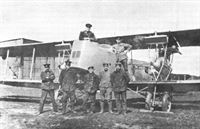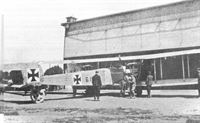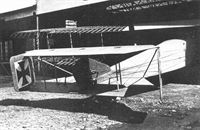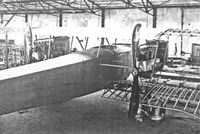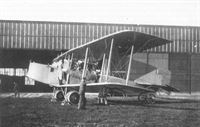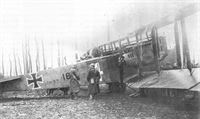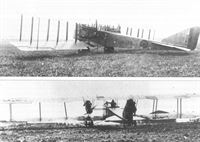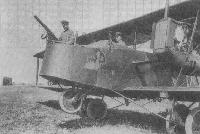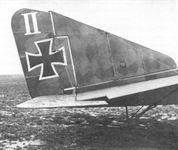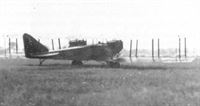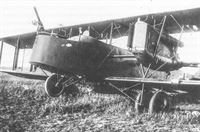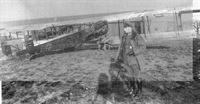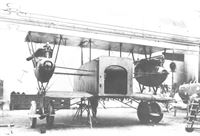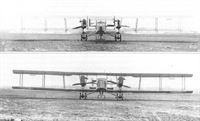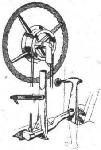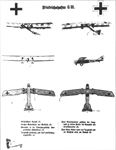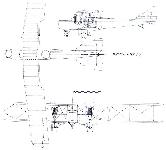
Описание
Страна: Германия
Год: 1915
Twin-engined long-range bomber
Варианты
- Friedrichshafen - G.I/G.II/G.III (FF30/FF38/FF45) - 1915 - Германия
- Friedrichshafen - G.IV (FF61) - 1918 - Германия
- Friedrichshafen - G.V (FF62) - 1918 - Германия
- В.Кондратьев Самолеты первой мировой войны
- А.Александров, Г.Петров Крылатые пленники России
- J.Herris Friedrichshafen Aircraft of WWI (A Centennial Perspective on Great War Airplanes 21)
- M.Dusing German Aviation Industry in WWI. Volume 2 (A Centennial Perspective on Great War Airplanes 85)
- O.Thetford, P.Gray German Aircraft of the First World War (Putnam)
- L.Andersson Soviet Aircraft and Aviation 1917-1941 (Putnam)
- J.Stroud European Transport Aircraft since 1910 (Putnam)
- P.Grosz, G.Haddow, P.Shiemer Austro-Hungarian Army Aircraft of World War One (Flying Machines)
- E.Hauke, W.Schroeder, B.Totschinger Die Flugzeuge der k.u.k. Luftfahrtruppe und Seeflieger 1914-1918
- Журнал Flight
-
J.Herris - Friedrichshafen Aircraft of WWI /Centennial Perspective/ (21)
Friedrichshafen G.III 180/17 aircraft '4' of Bogohl I, Bosta 2, downed in Belgian lines in February 1918. It was later painted in Belgian markings, including the Belgian royal coat of arms on the nose. It wears typical night camouflage fabric with two-tone blue mottle on ply and metal surfaces. All crosses were outlined.
-
J.Herris - Friedrichshafen Aircraft of WWI /Centennial Perspective/ (21)
Friedrichshafen G.III 367/17 aircraft '3' of Bogohl 8, Staffel 25, crewed by Oblt. von Gailsheim, Rittmeister von Beckmann, Lt. von Polnitz, and Uffz. Dorr at Maria Alter Aerodrome, summer 1918. The over-painted "26" on the fin may indicate the aircraft was transferred from Staffel 26.
-
J.Herris - Friedrichshafen Aircraft of WWI /Centennial Perspective/ (21)
Friedrichshafen G.III 369/17 aircraft ‘5’ of Bogohl 8, Bosta 25, crewed by Lt. Reinlein, Lt. Wetzlar, and Vzfw. Christi at Maria Alter Aerodrome, May 1918.
-
J.Herris - Friedrichshafen Aircraft of WWI /Centennial Perspective/ (21)
Friedrichshafen G.III aircraft '6' of Bogohl V, Staffel 4, summer 1917.
-
J.Herris - Friedrichshafen Aircraft of WWI /Centennial Perspective/ (21)
Friedrichshafen G.III G.1031/16 of Bogohl I, Bosta 3, flown by Oblt. Kupinger and Vzfw. Tillmanns during summer 1917. Finish is the original two-tone blue with CDL (clear-doped linen) undersurfaces, here made darker with black squiggles.
-
J.Herris - Friedrichshafen Aircraft of WWI /Centennial Perspective/ (21)
Friedrichshafen G.IIIa of Bogohl V, Staffel 6, possibly flown by the Staffel commander Oblt, von Doerstlingen.
-
J.Herris - Friedrichshafen Aircraft of WWI /Centennial Perspective/ (21)
Friedrichshafen G.IIIa of Bogohl I, Bosta 2. The manner in which the crosses were over-painted indicates around June 1918.
-
В.Обухович, А.Никифоров - Самолеты Первой Мировой войны
Фридрихсхафен G III
-
В.Кондратьев - Самолеты первой мировой войны
Friedrichshafen G-IIIa (862/18), 25 эскадрилья, 8 бомбардировочная эскадра ВВС Германии, 1918г.
-
J.Herris - Friedrichshafen Aircraft of WWI /Centennial Perspective/ (21)
Friedrichshafen G.IIIa G.823/18 of Bogohl VIII, Staffel 26, showing the final form of markings.
-
J.Herris - Friedrichshafen Aircraft of WWI /Centennial Perspective/ (21)
Friedrichshafen G.IIIa 1429/18. When being flown into captivity some German aircraft were ordered to wear a red fuselage band as seen here. This aircraft was photographed on display in Hyde Park, London in May 1919 without engines.
-
J.Herris - Friedrichshafen Aircraft of WWI /Centennial Perspective/ (21)
Friedrichshafen G.IIIa No.20 of the Thulin flying school at Ljungbyhed, Sweden in 1920.
-
J.Herris - Friedrichshafen Aircraft of WWI /Centennial Perspective/ (21)
Fdh FF30 (G.I) (1915). The first bomber designed by engineer Karl Gehlen at Flugzeugbau Friedrichshafen was the Friedrichshafen G.I, a biplane that was constructed at the end of 1914 and flew for the first time in 1915. The G.I bomber was produced in the usual design as a biplane, with a box tail unit and three seats, engine nacelles with pressure propellers. Only one aircraft was built (G.118/15). It is doubtful whether the G.I was used with its inadequate bomb load.
The Friedrichshafen G.I set the basic configuration for all following Friedrichshafen bombers. Only one prototype was built and evaluated before Idflieg ordered an improved, more powerful derivative, the Friedrichshafen G.II. (Peter M. Bowers Collection, Museum of Flight) -
O.Thetford, P.Gray - German Aircraft of the First World War /Putnam/
Friedrichshafen G I
-
J.Herris - Friedrichshafen Aircraft of WWI /Centennial Perspective/ (21)
A rare image of what is believed to be the sole Friedrichshafen G I of 1915, sire to an illustrious, if largely unsung series of bombers, that largely preceded the Gothas, were easier to fly and were built in comparable numbers. Little has survived concerning the G I other than that it used two 150hp Benz Bz IIIs and pre-dates the debut of the rival Gotha G II by the best part of a year.
Fdh FF36 (G.I). The FF.36 was FF's first attempt to build a twin-engine G-aircraft for the army. The prototype (serial number 100) underwent a type test on October 27, 1915 and was declared "approved" on November 19, 1915. No further orders were placed for this prototype. Extensive tests with the tail unit were necessary with this aircraft: first with a simple tail unit, then as a box and finally as an enlarged single tail unit in standard design. -
J.Herris - Friedrichshafen Aircraft of WWI /Centennial Perspective/ (21)
The Friedrichshafen G.I under construction. When more powerful engines were added to later Friedrichshafen designs, larger, taller rudders were required. (Peter M. Bowers Collection, Museum of Flight)
-
J.Herris - Friedrichshafen Aircraft of WWI /Centennial Perspective/ (21)
The Friedrichshafen G.I during construction; the G.I was designed without a rear gunner's position, a feature added to all operational Friedrichshafen bombers. Other than that, the subsequent Friedrichshafen bombers designs generally followed the basic configuration and structure of the G.I. (Peter M. Bowers Collection, Museum of Flight)
-
J.Herris - Friedrichshafen Aircraft of WWI /Centennial Perspective/ (21)
The Friedrichshafen G.I during flight evaluation, which revealed the need for more power. (Peter M. Bowers Collection, Museum of Flight)
-
J.Herris - Friedrichshafen Aircraft of WWI /Centennial Perspective/ (21)
A Friedrichshafen G.II in flight shows its two-bay wing bracing and typical Friedrichshafen configuration. The horizontal struts between the engine and fuselage below the upper longeron indicate either a prototype or a Daimler-built aircraft. (Peter M. Bowers Collection, Museum of Flight)
-
J.Herris - Friedrichshafen Aircraft of WWI /Centennial Perspective/ (21)
Apparently the Friedrichshafen G.II prototype with early vertical tail surfaces. (Peter M. Bowers Collection, Museum of Flight)
-
M.Dusing - German Aviation Industry in WWI. Volume 2 /Centennial Perspective/ (85)
Fdh FF38 (G.II) (1916). Two 200 hp Benz Bz.IV engines powered the second large aircraft from Friedrichshafen. A total of 9 aircraft were manufactured at Lake Constance, with a further 17 built under license by Daimler.
Apparently the Friedrichshafen G.II prototype with early vertical tail surfaces. (Peter M. Bowers Collection, Museum of Flight) -
J.Herris - Friedrichshafen Aircraft of WWI /Centennial Perspective/ (21)
Prototype G.II with initial tail design.
-
J.Herris - Friedrichshafen Aircraft of WWI /Centennial Perspective/ (21)
Prototype G.II with production tail design.
-
J.Herris - Friedrichshafen Aircraft of WWI /Centennial Perspective/ (21)
Friedrichshafen G.II 131/15, the G.II prototype, in the factory. Here it has been modified from its original configuration by a taller fin and balanced rudder. (Peter M. Bowers Collection, Museum of Flight)
Friedrichshafen G II, 131/15, seen here, was powered by two 215hp pusher-mounted Benz Bz IVs and carried a three man crew. The G II became operational in early 1916, but was only built in small numbers, being succeeded by the much larger Friedrichshafen G III, of which nearly 350 were built. -
J.Herris - Friedrichshafen Aircraft of WWI /Centennial Perspective/ (21)
The prototype Friedrichshafen G.II, G.131/15, at the factory. This photo shows the aircraft before modifications to the fuselage structure because the horizontal struts between the engine and fuselage are attached below the upper fuselage longeron.This feature was shared by Daimler-built aircraft but production Friedrichshafen-built aircraft had the struts attached to the upper longerons. (Peter M. Bowers Collection, Museum of Flight)
-
J.Herris - Friedrichshafen Aircraft of WWI /Centennial Perspective/ (21)
Another view of Friedrichshafen G.II G.134/15 showing the dramatic nose art that was applied. The horizontal engine struts attached to the upper fuselage longeron characterized production Friedrichshafen-built aircraft after structural modifications were applied to the fuselage. Only prototype Friedrichshafen-built aircraft had these struts mounted lower as seen on G.131/15. (Peter M. Bowers Collection, Museum of Flight)
-
J.Herris - Friedrichshafen Aircraft of WWI /Centennial Perspective/ (21)
Friedrichshafen G.II G.134/15 from the first G.II production batch.
-
J.Herris - Friedrichshafen Aircraft of WWI /Centennial Perspective/ (21)
A Friedrichshafen G.II(Daim), characterized by the horizontal struts between the engine and fuselage attaching below the upper longeron. This may be Daimler test pilot Irrek after the successful acceptance flight of the first G.II(Daim) 625.17 on March 3, 1917.
-
M.Dusing - German Aviation Industry in WWI. Volume 1 /Centennial Perspective/ (84)
Flugzeugbau Friedrichshafen FF38, here the G.II 6xx/16 built at Daimler DMG, Section Flugzeugbau.
-
M.Dusing - German Aviation Industry in WWI. Volume 1 /Centennial Perspective/ (84)
Friedrichshafen G.II(Daim) 625/16 was the first Friedrichshafen bomber built by Daimler, which produced 298 Friedrichshafen bombers under license. Here it is undergoing its type test at Adlershof in April 1917. The G.II was the first Friedrichshafen twin-engine bomber design to see production and operational service and established the basic pattern followed by all subsequent Friedrichshafen bomber designs.
-
O.Thetford, P.Gray - German Aircraft of the First World War /Putnam/
Friedrichshafen G II
-
J.Herris - Friedrichshafen Aircraft of WWI /Centennial Perspective/ (21)
A Friedrichshafen G.II(Daim) in the drainage ditch on the Daimler airfield at Sindelfingen. The ditch was the source of many complaints from Daimler test pilots. (Peter M. Bowers Collection, Museum of Flight)
-
J.Herris - Friedrichshafen Aircraft of WWI /Centennial Perspective/ (21)
Friedrichshafen G.III 1030/16 ordered in November 1916 was the first production G.III.
-
J.Herris - Friedrichshafen Aircraft of WWI /Centennial Perspective/ (21)
Friedrichshafen G.III 1031/16 of Kampfstaffel 3.
-
J.Herris - Friedrichshafen Aircraft of WWI /Centennial Perspective/ (21)
This early model Friedrichshafen G.III still has the windows in the nose like the earlier G.II.
-
J.Herris - Friedrichshafen Aircraft of WWI /Centennial Perspective/ (21)
Friedrichshafen G.III 167/17 in night bomber camouflage. (Peter M. Bowers Collection/Museum of Flight)
-
J.Herris - Friedrichshafen Aircraft of WWI /Centennial Perspective/ (21)
Friedrichshafen G.III 179/17 was covered with the typical dark, night bomber printed camouflage fabric.
-
J.Herris - Friedrichshafen Aircraft of WWI /Centennial Perspective/ (21)
Friedrichshafen G.III 180/17 of Bogohl I, Bosta 2 was brought down near Ghent, Belgium in February 1918.
-
J.Herris - Friedrichshafen Aircraft of WWI /Centennial Perspective/ (21)
Friedrichshafen G.III 180/17 of Bogohl 3, Bosta 2 brought down in Belgium in its original markings.
-
J.Herris - Friedrichshafen Aircraft of WWI /Centennial Perspective/ (21)
Friedrichshafen G.III 180/17 of Bogohl 3, Bosta 2 brought down in Belgium in its original markings. It carried a crown insignia on a shield. The bracket for the landing lights is visible under the nose.
-
J.Herris - Friedrichshafen Aircraft of WWI /Centennial Perspective/ (21)
Friedrichshafen G.III 180/17 of Bogohl 3, Bosta 2 brought down in Belgium. The image shows details of the engine, propeller, and rear gunner's cockpit.
-
J.Herris - Friedrichshafen Aircraft of WWI /Centennial Perspective/ (21)
Friedrichshafen G.III 180/17 of Bogohl 3, Bosta 2 brought down in Belgium. The image shows details of the engine cowling and radiator. The aircraft type and serial are clearly visible on the engine cowling.
-
J.Herris - Friedrichshafen Aircraft of WWI /Centennial Perspective/ (21)
Friedrichshafen G.III 180/17 of Bogohl 3 brought down in Belgium February 18, 1918, in its original markings.
-
J.Herris - Friedrichshafen Aircraft of WWI /Centennial Perspective/ (21)
Friedrichshafen G.III 180/17 of Bogohl I brought down in Belgium after conversion to Belgian markings.
-
J.Herris - Friedrichshafen Aircraft of WWI /Centennial Perspective/ (21)
Friedrichshafen G.III 180/17 of Bogohl 1, Bosta 2 after capture in February 1918 with Belgian insignia applied.
-
J.Herris - Friedrichshafen Aircraft of WWI /Centennial Perspective/ (21)
This Friedrichshafen G.III has a test probe fitted on the nose and has rudder stripes indicating an aircraft captured by the Allies. It is likely G.III 180/17.
-
J.Herris - Friedrichshafen Aircraft of WWI /Centennial Perspective/ (21)
Friedrichshafen G.III 180/17 under evaluation at the French test center at Villacoublay. Like the Gotha G.V which it resembled, the Friedrichshafen G.III used 260 hp Mercedes D.IVa engines mounted in nacelles above the wing. The nosewheel helped prevent nose-overs during landing, one factor that made it safer to fly than Gothas. Another factor in flight safety was the center of gravity was in the right place, not aft like the Gotha bombers.
-
H.Cowin - Aviation Pioneers /Osprey/
Although always overshadowed in the public eye by the Gotha name, the Friedrichshafen G III equipped three of the eight German bomber wings at the time of the Armistice. Larger and heavier than the contemporary Gotha G IV, the G III carried a far heavier bomb load and seemed far less susceptible to the landing gear failures that constantly beset the Gothas. With a 3-man crew, the G III was powered by two 260hp Mercedes D IVs and could carry up to 3,300 lb of bombs. Armed with two or three 7.92mm Parabellums, the G III had a top level speed of 87mph at 3,280 feet, along with a duration of 5 hours, implying a tactical radius of action, with full bomb load, of around 140 to 145 miles. Deployed initially in mid-1917, the G III and G IIIa went on to equip KG 1, KG 2 and KG 4 during 1917 and 1918.
-
В.Кондратьев - Самолеты первой мировой войны
"Фридрихсхафен" G-III на западном фронте, осень 1917г.
-
J.Herris - Friedrichshafen Aircraft of WWI /Centennial Perspective/ (21)
Frontal view of Friedrichshafen G.III bomber.
-
Jane's All The World Aircraft 1919 /Jane's/
Three-quarter Front View of a Friedrichshafen G.III Bomber.
-
M.Dusing - German Aviation Industry in WWI. Volume 2 /Centennial Perspective/ (85)
Fdh FF45 (G.III) (1917). The Fdh G.III was a successful large land bomber, of which 134 were built. The type test was successfully completed on April 17, 1917. The aircraft used two 260 hp Mercedes D.IVa engines. It was built under license by Daimler in Sindelfingen, Caspar in Hamburg, Oeffag Wiener-Neustadt, and, at the end of 1918, by the Gothaer Waggonfabrik.
-
J.Herris - Friedrichshafen Aircraft of WWI /Centennial Perspective/ (21)
This Friedrichshafen G.III of Staffel 3/Bogohl I, stationed at Tupigny, France, 1918, displays an elaborate coat of arms on the nacelle. Landing lights are also prominently placed under the nose to provide sufficient light for landing in dark or foggy conditions. Vzfw. Sturm was the aircraft commander. (Peter M. Bowers Collection/Museum of Flight)
-
J.Herris - Friedrichshafen Aircraft of WWI /Centennial Perspective/ (21)
Frontal views of Friedrichshafen G.III bombers.
-
J.Herris - Friedrichshafen Aircraft of WWI /Centennial Perspective/ (21)
Frontal views of Friedrichshafen G.III bombers.
-
J.Herris - Friedrichshafen Aircraft of WWI /Centennial Perspective/ (21)
This Friedrichshafen G.III has spinners on its propellers and appears to be at the Daimler factory.
-
M.Dusing - German & Austro-Hungarian Aero Engines of WWI. Vol.2 /Centennial Perspective/ (65)
Mercedes D IVa in Friedrichshafen G.III.
-
J.Herris - Friedrichshafen Aircraft of WWI /Centennial Perspective/ (21)
Tail details of a Friedrichshafen G.III. The pattern of the night-bomber camouflage fabric shows up well; often it is too dark to show up clearly.
-
J.Herris - Friedrichshafen Aircraft of WWI /Centennial Perspective/ (21)
A Friedrichshafen G.III bomber in a hangar in the Netherlands.
-
J.Herris - Friedrichshafen Aircraft of WWI /Centennial Perspective/ (21)
An early-production Friedrichshafen G.III - note the windows in the nose - shares the field with the Albatros D.V D1016/17 of Ltn. von der Marwitz of Jasta 30 in June 1917.
Другие самолёты на фотографии: Albatros D.V/D.Va - Германия - 1917
-
J.Herris - Friedrichshafen Aircraft of WWI /Centennial Perspective/ (21)
This view shows the early-production Friedrichshafen G.III is from Kampfstaffel 5. The tail of the Albatros D.V of Ltn. von der Marwitz is barely visible behind the bomber.
Другие самолёты на фотографии: Albatros D.V/D.Va - Германия - 1917
-
J.Herris - Friedrichshafen Aircraft of WWI /Centennial Perspective/ (21)
Another view of the early-production Friedrichshafen G.III from Kampfstaffel 5. Fighter pilots from Jasta 30 relax between sorties during the day while a Friedrichshafen G.III night bomber appears in the background. Fighter crews flew primarily from dawn till dusk while the Friedrichshafen bomber crews often flew under the cover of darkness. Ltn. von der Marwitz Albatros has been moved. In the foreground Jasta 30 pilots prepare for their next combat.
-
J.Herris - Friedrichshafen Aircraft of WWI /Centennial Perspective/ (21)
Friedrichshafen G.III(Daim) 241/17 was the second G.III built by Daimler under license. In an attempt to maximize its performance by minimizing drag the pusher propeller even has a spinner fitted.
-
M.Dusing - German Aviation Industry in WWI. Volume 1 /Centennial Perspective/ (84)
Friedrichshafen G.III(Daim) 25X/17 sports its iron cross high on its rudder, characteristice of Daimler-built G.IIIs.
-
A.Imrie - German Bombers /Arms & Armour/
The landing lights built into the top wing leading edges of this Friedrichshafen G III (271/17) used low-resistance bulbs, fed by a battery of 12-volt accumulators, and they could illuminate the ground for a distance of 50m ahead from a height of 4m. The aerodrome lighting did not always provide the necessary reference to allow the pilot to place his aeroplane in the correct landing attitude at the right height, and the nosewheel undercarriage was used to lessen the risk of damage by flying into the ground.
-
O.Thetford, P.Gray - German Aircraft of the First World War /Putnam/
Friedrichshafen G III (serial 271/17)
-
J.Herris - Friedrichshafen Aircraft of WWI /Centennial Perspective/ (21)
Friedrichshafen G.III(Daim) 356/17 was one of a batch of 100 ordered in June 1917 and wears a personal marking on the side of its nose. It has no rudder cross and the fuselage cross does not have a white outline.
-
J.Herris - Friedrichshafen Aircraft of WWI /Centennial Perspective/ (21)
The Friedrichshafen G.III, which followed the basic configuration of all Friedrichshafen bombers, was the main production type. Its configuration was very similar to the Gotha series but the Friedrichshafen had much better handling qualities that made it a safer airplane to fly, especially during landing. This bomber is G.III 360/17.
-
A.Imrie - German Bombers /Arms & Armour/
Staffelfuehrer's Friedrichshafen G III 367/18 of Bosta 25, Bogohl VIII. Rittmeister Freiherr von Beckmann is in the observer's front cockpit: the Staffelfuehrer, Oberleutnant Freiherr von Crailsheim (with signal flares in his top pocket), and Leutnant Freiherr von Polnitz in the pilot's cockpit. The non-optical Goerz bombsight on the nose was more suitable for use at night than the 'bombing telescope'. It consisted of a fixed foresight at the apex of the triangular frame and an illuminated backsight at the top which was set with height and groundspeed; when the target entered the crosswires on the backsight, and lined up with the foresight, the bombs were released.
-
J.Herris - Friedrichshafen Aircraft of WWI /Centennial Perspective/ (21)
Friedrichshafen G.III(Daim) 392/17 prepares for a flight from the Daimler factory at Sindelfingern. The rudder cross is located at the top of the rudder, a hallmark of Daimler-built G.III bombers. Interestingly, there are no crosses on the upper wing surfaces.
-
J.Herris - Friedrichshafen Aircraft of WWI /Centennial Perspective/ (21)
A Friedrichshafen G.III on its take-off run.
-
J.Herris - Friedrichshafen Aircraft of WWI /Centennial Perspective/ (21)
A Friedrichshafen G.III 828/17 comes in for a landing.
-
J.Herris - Friedrichshafen Aircraft of WWI /Centennial Perspective/ (21)
Friedrichshafen G.III 828/17 landed in the Netherlands and was interned.
-
J.Herris - Friedrichshafen Aircraft of WWI /Centennial Perspective/ (21)
Another view of Friedrichshafen G.III 828/17 that landed in the Netherlands and was interned.
-
J.Herris - Friedrichshafen Aircraft of WWI /Centennial Perspective/ (21)
Friedrichshafen G.III 828/17 landed in the Netherlands and was interned.
-
J.Herris - Friedrichshafen Aircraft of WWI /Centennial Perspective/ (21)
This Friedrichshafen G.III of Kampfstaffel 3 has unusual unit-applied camouflage under its wings.
-
J.Herris - Friedrichshafen Aircraft of WWI /Centennial Perspective/ (21)
Friedrichshafen G.III and G.IIIa bombers of Bogohl I in 1918.
-
A.Imrie - German Bombers /Arms & Armour/
Two Friedrichshafen G III machines on a training aerodrome in Germany, probably the Geschwaderschule at Paderborn, in April 1918. The nearest aircraft (G 347/17) has the box tail unit that became standard on the G IIIa; it also has the four-bay wing cellule that was the hallmark of the G IV, and is possibly one of the prototype aircaft used to introduce these features, brought to Paderborn for demonstration purposes. Pilots were converted to twin-engined types at this school. After flying solo, flights were made with increasing amounts of ballast up to maximum weight, by both day and night. Cross-country flights were undertaken during which specified periods had to be spent above a height of 2,000m. The final requirements included day and night exercises on the bombing range. Duration of courses varied but could take up to eight weeks.
-
J.Herris - Friedrichshafen Aircraft of WWI /Centennial Perspective/ (21)
This image lend scale and substance to Friedrichshafen's G IIIa. Operationally deployed for the first time during the spring of 1918, the G IIIa used the same engines as the G III, differing only in the adoption of a biplane tail unit. Production of the 345 G III and G IIIa aircraft was shared between the parent company, Hanseatische and Daimler.
-
J.Herris - Friedrichshafen Aircraft of WWI /Centennial Perspective/ (21)
Friedrichshafen 511/18 was a transition aircraft; it was ordered as a G.III but was given the box tail and Flettnertabs of a G.IIIa during production at the factory.
-
J.Herris - Friedrichshafen Aircraft of WWI /Centennial Perspective/ (21)
Friedrichshafen G IIIa (Daim.) 779/18. This view of a sub-contract machine built by Daimler shows the Flettner balances mounted ahead of the aileron hinges on outriggers (Flettner tabs, Hilfsruder) and details of the box tail (Kastensteuer). Not only were twin-engined aircraft of the time unable to maintain height on one engine, but full power on the good engine caused the loss of directional control. During 1918 much experimental work resulted in the 'box tail unit' being adopted by AEG, Friedrichshafen and Gotha. The main asset was the placing of the rudder in the propeller slipstream where it benefitted from increased airflow, allowing straight ahead flight at full power on one engine, the rate of descent being considerably reduced. The biplane configuration of the tail unit was merely the best way to produce a braced structure strong enough to support the vertical tail surfaces.
-
J.Herris - Friedrichshafen Aircraft of WWI /Centennial Perspective/ (21)
Friedrichshafen G.IIIa 779/18.
-
J.Herris - Friedrichshafen Aircraft of WWI /Centennial Perspective/ (21)
Engine details of Friedrichshafen G.III(Daim) 779/18, the last aircraft of a batch of 30. Some of these aircraft, like 779/18, were transition aircraft with the G.IIIa box tail (Kastensteuer) and Flettner tabs (Hilfsruder).
-
P.Grosz, G.Haddow, P.Shiemer - Austro-Hungarian Army Aircraft of World War One /Flying Machines/
Friedrichshafen G.IIIa(Daim) 789/17 awaiting propeller installation in the Oeffag flight hangar at Wiener-Neustadt.
-
P.Grosz, G.Haddow, P.Shiemer - Austro-Hungarian Army Aircraft of World War One /Flying Machines/
All but the largest German aircraft were designed to be disassembled for rail shipment. The Friedrichshafen G.IIIa (Daim) 789/17 center fuselage module is in process of assembly after arrival at the Oeffag factory.
-
M.Dusing - German Aviation Industry in WWI. Volume 2 /Centennial Perspective/ (85)
Friedrichshafen G.IIIa was equipped with Niendorf propellers (diameter 3.08 m). They consisted of nine layers, alternating ash and walnut; one leaf seems to be maple. The screw wing ends had 25 cm long brass fittings, the pitch of the propeller was 1.8 m and the maximum blade width was 22 cm.
-
J.Herris - Friedrichshafen Aircraft of WWI /Centennial Perspective/ (21)
Friedrichshafen G.IIIa G.789/18 (789/17 ???) at Oeffag in August 1918; this aircraft had 250 hp Benz Bz.IV(Mar) engines built in Austria instead of the usual 260 hp Mercedes. The G.IIIa featured a number of improvements over the G.III. The most obvious was the 'box' tail to improve directional control with one engine inoperative. Other improvements included a 'Gotha tunnel' to improve the rear gunner's downward field of fire, greater fuel capacity for longer range, greater bombload, and Flettner servo-tabs on the ailerons to reduce the control forces and thus the pilot's workload.
-
P.Grosz, G.Haddow, P.Shiemer - Austro-Hungarian Army Aircraft of World War One /Flying Machines/
The G.IIIa(Daim) 789/17 fully assembled and ready for flight trials on the Oeffag airfield. Neither of the two Friedrichshafen bombers delivered to Oeffag received an LFT designation number.
-
A.Imrie - German Bombers /Arms & Armour/
Oberleutnant Freiherr Marschall von Bieberstein, Staffelfuehrer of Bosta II in Bogohl I, with his pilot, Leutnant Nieber, in front of their Friedrichshafen G IIIa 836/18. One of the most resolute bomber commanders, von Bieberstein, for whom the heaviest anti-aircraft fire held no terrors, rejoiced in the nickname of 'Emir - enemy of the infidels'. The decorative laurel wreath on the nose of his aircraft is in celebration of his return from his 250th operational flight.
-
M.Dusing - German Aviation Industry in WWI. Volume 1 /Centennial Perspective/ (84)
Friedrichshafen G.IIIa(Daim) 1052/18.
-
J.Herris - Friedrichshafen Aircraft of WWI /Centennial Perspective/ (21)
The Friedrichshafen G.IIIa(Daim) series 07 bomber ordered from Daimler would have been similar to this G.IIIa(Daim) 1056/18, shown in French hands after the war. The top ailerons are fitted with Flettner servo tabs originally developed for guided missiles.
Friedrichshafen G.IIIa(Daim) 1056/18 was turned over to the French according to the terms of the Armistice. Ordered in October 1918 and in pristine condition, it was probably delivered straight from the factory. -
J.Herris - Friedrichshafen Aircraft of WWI /Centennial Perspective/ (21)
Friedrichshafen 1425/18 in derelict condition postwar. It was ordered as a G.III but completed with the G.IIIa tail. The fuselage insignia have been cut out for souvenirs. An LVG C.VI missing its rudder rests at left.
Другие самолёты на фотографии: LVG C.VI - Германия - 1918
-
J.Herris - Friedrichshafen Aircraft of WWI /Centennial Perspective/ (21)
Friedrichshafen G.IIIa 1429/18 without engines on display in Hyde Park, London on 14 May 1919.
-
Журнал - Flight за 1919 г.
"NOT A CASE OF BIRDS OF A FEATHER," etc. - The "bird" in the background is a captured German bomber now exhibited sans engine in St. James's Park. The flyer in the foreground is of a much more peaceful character, and hails, we believe, from China.
-
M.Dusing - German Aviation Industry in WWI. Volume 2 /Centennial Perspective/ (85)
Fdh FF45 (G.IIIa) (1917). In the spring of 1918, the G.III was redesigned as the G.IIIa. The payload was 1,500 kg. The G.IIIa received a box-shaped tail unit and the "Gotha" firing channel, the "AEG gasoline circuit", MG stations with open pivot. The machine gunners/observers had a passageway from the front part of the fuselage to the rear. Radio communication was possible from the front and rear MG stations.
-
J.Herris - Friedrichshafen Aircraft of WWI /Centennial Perspective/ (21)
Friedrichshafen G.III with aircrew and ground-crew members during bomb loading demonstrating a 300 kg P.u.W. bomb.
-
J.Herris - Friedrichshafen Aircraft of WWI /Centennial Perspective/ (21)
Friedrichshafen G.III being loaded with 50 kg bombs. The radiator details and forward gunner's position are nicely shown. A pintle mount for a second flexible forward-firing machine gun is mounted between the cockpits.
-
J.Herris - Friedrichshafen Aircraft of WWI /Centennial Perspective/ (21)
The crew of a Friedrichshafen G.IIIa carrying a 1,000 kg PuW bomb poses with their aircraft.
-
A.Imrie - German Bombers /Arms & Armour/
Friedrichshafen G IIIa of Bosta 26. Bogohl VIII, with a 1,000kg bomb in its rack. This machine, probably the best G type to reach the Front in quantity, was actually capable of carrying a 1,500kg bombload with fuel for 6 hours. The already excellent undercarriage was further strengthened for heavy work by doubling the number of wheels originally fitted. Two hefty streamlined-section steel tubes filled with wood extended from the wing spars to a steel girder that supported the axles; shock-absorption was by coiled steel springs, this assembly being covered by a fabric bag to prevent the ingress of mud, etc. The nose wheel shock struts also used steel springs in compression. All undercarriage assemblies had drift bracing of streamlined steel tube; that on the main wheels precluded the use of bomb racks on the wing undersurfaces of the centresection.
-
A.Imrie - German Bombers /Arms & Armour/
Close-up of the 1,000kg P.u.W. bomb on its simple rack showing the nose safety pin in place. This weapon was first dropped experimentally in December 1917, had two fuses and was thin-walled to obtain the maximum blast effect from its 680kg of high-explosive. The angled tail fins imparted a rotary motion to the bomb during its fall which stabilized its trajectory. The centrifugal force generated was used to arm the bomb by causing three brass segments to move clear of the firing pistol, and needed a fall of 1,600m to operate. First live drops were made in January 1918 and 710 bombs of this type had been dropped on enemy targets by the end of the war.
-
J.Herris - Friedrichshafen Aircraft of WWI /Centennial Perspective/ (21)
The Friedrichshafen G.III was capable of carrying a 1,000 kg PuW (Prufanstalt und Werff) bomb as shown here. This bomb was first used in combat in January 1918.
-
J.Herris - Friedrichshafen Aircraft of WWI /Centennial Perspective/ (21)
Close up of the ground crew preparing a Friedrichshafen G.III for a mission.
-
J.Herris - Friedrichshafen Aircraft of WWI /Centennial Perspective/ (21)
Friedrichshafen G.IIIa 862/18 of Bogohl 8 in October 1918 during a flight for parachute testing.
-
A.Imrie - German Bombers /Arms & Armour/
On the crew state board (at caption No 72) Oberleutnant Karl lletzel had just reported to Bogohl VIII. Possibly because of his rank and the fact that Bosta 25 was below the established pilot strength, he was assigned to Bosta 25, taking over Leutnant Reinlein's crew: Leutnant Wetzlar, observer, and Vizefeldwebel Christl, machinegunner. He is seen here flying Friedrichshafen G IIIa 826/18 with these crew members on a practice flight which involved dropping parachute stores from the bottom hatch of the gunner's cockpit. This photograph, which is one of a sequence, was taken by Leutnant Woyl in the vicinity of Bolchen in Lothringen in October 1918.
-
A.Olejko - War Wings Over Galicia 1918-1919 /Aeronaut/
Allies... During the fights in 1920 on the Ukrainian Front in the composition of the 21st Destroyer Squadron, combat flights as an observer were carried out together with Polish pilots Captains observer Arthur Kelly. He died along with Second Lieutenant Stanislaw Skarzynski on July 15, 1920 in a downed LVG C.V aircraft from this squadron. The photo shows a Friedrichshafen G.IIIa bomber from the 21st Destroyer Squadron in flight. (W. Sankowski's collection)
-
J.Herris - Friedrichshafen Aircraft of WWI /Centennial Perspective/ (21)
This Friedrichshafen G.IIIa has attracted a great deal of attention, probably postwar.
-
J.Herris - Friedrichshafen Aircraft of WWI /Centennial Perspective/ (21)
The circumstances of this photo are unknown, but the robust Friedrichshafen G.IIIa dwarfs the fragile Bieriot.
Другие самолёты на фотографии: Bleriot Bleriot-XI-2 - Франция - 1911
-
R.Bennett - Last Gathering of Eagles 1918-1920 /Aeronaut/
Lithuania's treasure trove of German aircraft found a new home in the Aleksotas airship shed, itself formerly German property. At the bottom center is the ill-fated Friedrichshafen G.IIIa bomber under reconstruction. Other identifiable aircraft are Fokker D.VII, Halberstadt CL.II and IV, DFW C.V, LVG C.V, Albatros C.III, C.XV, and J.II. Fifth aircraft to the right of the Friedrichshafen is the Halberstadt CL.IV shown in the accompanying profile. (Moshe Bukhman)
Другие самолёты на фотографии: Fokker D.VII / V11 / V18 / V22 / V24 - Германия - 1917Halberstadt CL.IV - Германия - 1918
-
J.Herris - Gotha Aircraft of WWI /Centennial Perspective/ (6)
Postwar lineup of a Gotha GL.VII (at left), an AEG (center), and a Friedrichshafen (at right) at Bickendorf. The GL.VII has a fuselage band over the cross insignia, its location indicating it was built by Aviatik.
Другие самолёты на фотографии: AEG G.IV - Германия - 1916Gotha GL.VII/GL.VIII - Германия - 1918
-
J.Herris - Friedrichshafen Aircraft of WWI /Centennial Perspective/ (21)
A Friedrichshafen G.IIIa in British markings postwar.
-
J.Herris - Friedrichshafen Aircraft of WWI /Centennial Perspective/ (21)
Friedrichshafen G.IIIa photographed in British hands postwar.
-
J.Herris - Friedrichshafen Aircraft of WWI /Centennial Perspective/ (21)
This Friedrichshafen G.IIIa was turned over to the British postwar.
-
J.Herris - Friedrichshafen Aircraft of WWI /Centennial Perspective/ (21)
Friedrichshafen G.IIIa photographed postwar. The box tail and Flettnertabs gave the pilot better control, especially in asymmetric thrust conditions after an engine failed.
-
J.Herris - Friedrichshafen Aircraft of WWI /Centennial Perspective/ (21)
Friedrichshafen G.IIIa tail details.
-
J.Herris - Friedrichshafen Aircraft of WWI /Centennial Perspective/ (21)
Experimental tail surfaces tested for the Friedrichshafen G.IIIa shows the fixed center fin that was tested but did not reach production. The rudders also appear to have longer chord than the production rudders. Designers constantly tried new tail designs to improve flying qualities and controllability after an engine failure.
-
J.Herris - Gotha Aircraft of WWI /Centennial Perspective/ (6)
Gotha G.IX(LVG) serving in Belgium postwar illustrates the type's clean lines. It appears to be on public display. A Friedrichshafen bomber is in the background.
Другие самолёты на фотографии: Gotha G.IX / G.X - Германия - 1918
-
J.Herris - Friedrichshafen Aircraft of WWI /Centennial Perspective/ (21)
Photographed in 1920, Friedrichshafen G.IIIa "20" was in Swedish markings at Sweden's Thulin flying school at Ljungbyhed. It had been delivered from Hamburg on 15 January 1920 and here has gained the attention of a group of four men and two women.
The Friedrichshafen G.IIIa competed with the AEG for the best German night bomber. Both the Friedrichshafen and AEG bombers had better, safer handling qualities than the more famous Gotha bombers. Gotha was never able to solve the center of gravity problems of the Gotha bombers that made them difficult to fly and land. Gotha twin-engine floatplanes suffered from similar issues. -
J.Herris - Friedrichshafen Aircraft of WWI /Centennial Perspective/ (21)
This appears to be the group of four men and two women photographed in Friedrichshafen G.IIIa "20" at Sweden's Thulin flying school at Ljungbyhed with the aircraft in the background.
-
J.Herris - Friedrichshafen Aircraft of WWI /Centennial Perspective/ (21)
Friedrichshafen G.IIIa(Daim) 1037/18 was modified to a passenger transport after the war and registered D 121, is shown here serving with the Deutsche Luftreederei. The Treaty of Versailles put an end to this service.
-
J.Stroud - European Transport Aircraft since 1910 /Putnam/
The Friedrichshafen G IIIa D-121 of Deutsche Luft-Reederei.
-
Журнал - Flight за 1918 г.
Fig. 1. - Centre section of lower main plane with three-ply surfacing removed.
-
Журнал - Flight за 1918 г.
Fig. 20. - View looking down inside of fuselage from the main nacelle, showing trap-door and after-gunner's folding seat.
-
Журнал - Flight за 1918 г.
Fig. 22. - Front portion of the nacelle.
-
Журнал - Flight за 1918 г.
Fig. 23. - Inside of the front cockpit.
-
Журнал - Flight за 1918 г.
Fig. 30. - The exhaust pipe of the 260 h.p. Mercedes engine.
-
Журнал - Flight за 1918 г.
Fig. 37. - Gravity petrol tank let into the centre section of the upper plane. Its fabric cover is held down by press buttons. Note the detachable panel in the trailing edge of the plane.
-
Журнал - Flight за 1918 г.
Figs. 40 and 41. - Front and side views of the propeller. Note the two additional bolt holes.
-
Журнал - Flight за 1918 г.
Fig. 46. - Main landing chassis with fabric fairing removed.
Fig. 47. - Landing wheel under the front portion of the nacelle. -
Журнал - Flight за 1918 г.
Fig. 48. - Tail skid.
Fig. 49. - Machine gun mounting in the front portion of the nacelle. -
Журнал - Flight за 1918 г.
Fig. 54. - View of bomb-rack in nacelle. Behind it can be seen the spring of trimming gear.
-
Журнал - Flight за 1918 г.
Fig. 55. - Large bomb-carrier.
-
Журнал - Flight за 1918 г.
Fig. 56. - Bomb-release gear inside front cockpit.
-
А.Александров, Г.Петров - Крылатые пленники России
(КПР 85)
Two civil German Friedrichshafen G IIIa bombers equipped for passenger transport were confiscated by the Soviets and entered service with the RKKVF in 1920. -
J.Herris - Friedrichshafen Aircraft of WWI /Centennial Perspective/ (21)
The cockpit of a Friedrichshafen G.III. There was only one control wheel; there was a pilot but no copilot. The 12 controls on the center and upper right enable the pilot to manage the flow from the fuel tanks.
-
J.Herris - Friedrichshafen Aircraft of WWI /Centennial Perspective/ (21)
The passage allowing movement between the rear cockpit and the pilot's cockpit was introduced on the Friedrichshafen G.IIIb. The forward fuselage of this aircraft has not yet been completed.
-
J.Herris - Friedrichshafen Aircraft of WWI /Centennial Perspective/ (21)
A Friedrichshafen G.IIIb under construction?
-
J.Herris - Friedrichshafen Aircraft of WWI /Centennial Perspective/ (21)
Becker 2cm cannon tested in Friedrichshafen G.IIIa.
-
J.Herris - Friedrichshafen Aircraft of WWI /Centennial Perspective/ (21)
"Gotha"gun tunnel added to Friedrichshafen G.IIIa.
-
D.Mechin - Oriental Adventures of the French Air force 1914-1918 /Aeronaut/
Friedrichshafen G.III bomber shot down by the British Air Force on April 8, 1917. (Coll Benoit Henriet)
-
J.Herris - Friedrichshafen Aircraft of WWI /Centennial Perspective/ (21)
This crashed Friedrichshafen G.III shows the hatch in the bottom of the fuselage to enable the rear gunner to fire downward to the rear to defend against fighters.
-
J.Herris - Friedrichshafen Aircraft of WWI /Centennial Perspective/ (21)
A crashed Friedrichshafen G.III spills its bombload.
-
Журнал - Flight за 1918 г.
Fig. 2. Fig. 3. Fig. 4. Fig. 5. Fig. 6.
-
Журнал - Flight за 1918 г.
Fig. 7. Fig. 8. Fig. 9. Fig. 10.
-
Журнал - Flight за 1918 г.
Fig. 11. Fig. 12. Fig. 13. Fig. 14. Fig. 15.
-
Журнал - Flight за 1918 г.
Fig. 16. Fig. 17. Fig. 18. Fig. 19.
-
Журнал - Flight за 1918 г.
Fig. 21.
-
Журнал - Flight за 1918 г.
Fig. 24. Fig. 25.
-
Журнал - Flight за 1918 г.
Fig. 26. Fig. 27.
-
Журнал - Flight за 1918 г.
Fig. 28. Fig. 29.
-
Журнал - Flight за 1918 г.
Fig. 31. Fig. 32.
Fig. 33. - Radiator, with shutter open.
Fig. 34.
Fig. 35. - Oil tank. This is placed Immediately behind the radiator.
Fig. 36. -
Журнал - Flight за 1918 г.
Fig. 38. Fig. 39.
-
Журнал - Flight за 1918 г.
Fig. 42.
-
Журнал - Flight за 1918 г.
Fig. 43. Fig. 44.
-
Журнал - Flight за 1918 г.
Fig. 45.
-
Журнал - Flight за 1918 г.
Fig. 50. Fig. 51. Fig. 52. Fig. 53.
-
J.Herris - Friedrichshafen Aircraft of WWI /Centennial Perspective/ (21)
Friedrichshafen G.III recognition chart provided to German units.
-
Jane's All The World Aircraft 1919 /Jane's/
The 450-h.p. Friedrichshafen G.II Three-seater.
-
Журнал - Flight за 1918 г.
General arrangement drawings of the Friedrichshafen bomber.
-
A.Imrie - German Bombers /Arms & Armour/
Friedrichshafen Type G.III
-
В.Кондратьев - Самолеты первой мировой войны
"Фридрихсхафен" G-III
В.Кондратьев Самолеты первой мировой войны
ФРИДРИХСХАФЕН G-II/G-III / FRIDRICHSHAFEN G-II/G-III
Фирма Флюгцойгбау Фридрихсхафен, более известная своими поплавковыми гидропланами, еще в 1914 году предприняла попытку создания двухмоторного бомбардировщика. Но самолет (фабричное обозначение FF-30) получился неудачным и не пошел в серию.
К идее тяжелых многомоторных машин фирма вернулась в 1916 году, вероятно, под влиянием известий об успехах бомбардировщиков "Гота". Следующий образец Фридрихсхафена - двухмоторный двухстоечный биплан FF38 в конце 1916-го приняли на вооружение под индексом G-II. Однако машина обладала слишком малой для своего класса бомбовой нагрузкой. Было построено всего несколько экземпляров, применявшихся на западном фронте в 1917 году.
Гораздо большее распространение получила очередная модель "Фридрихсхафен" G-III (FF45), составившая серьезную конкуренцию бомбовозам фирмы Гота. Новый "Фридрихсхафен" появился в начале 1917 года, примерно тогда же, когда Гота испытывала свой знаменитый G-IV. Не знаю, можно ли тут говорить о заимствовании, но оба самолета получились чрезвычайно похожими друг на друга. Даже геометрические размеры и массы совпадали с удивительной точностью.
Кроме того, обе машины оснащались одинаковыми двигателями, только на "Фридрихсхафене" они не крепились к нижнему крылу, а "подвешивались" на стойках, как это позднее сделали на "Готе" G-V. Другими внешними отличиями "Фридрихсхафена" была несколько иная форма оперения и носовое противокапотажное колесо.
Конструкция самолета смешанная. Ряд силовых элементов крыла и фюзеляжа, а также каркас оперения выполнен из стальных труб. Обшивка тоже смешанная: в передней части фюзеляжа и центроплане нижнего крыла - фанерная, а на остальных поверхностях - полотно. Экипаж - 3 человека: летчик, носовой стрелок-бомбардир и хвостовой стрелок.
Летные характеристики "Фридрихсхафена" в целом соответствовали данным "Готы", но бомбовая нагрузка оказалась в полтора раза выше. Самолет приняли на вооружение в качестве дальнего бомбардировщика и запустили в серию.
Помимо фирмы-разработчика, "Фридрихсхафены" G-III выпускали заводы Ханзейтиш Флюгцойгверк (Ганза) и Даймлер Флюгцойгбау. В небольших количествах строилась также модификация G-IIIa с двухкилевым бипланным оперением и без носового колеса. Всего построено 245 бомбардировщиков обоих типов.
"Фридрихсхафены" до конца войны применялись наряду с "Готами" в качестве дневных и ночных бомбардировщиков против целей во Франции, Бельгии и Великобритании. В дальнейшем немцы использовали уцелевшие машины в качестве транспортно-пассажирских.
В 1920 году два таких самолета были закуплены советской Россией и еще несколько лет летали в составе Красного воздушного флота. Еще один аппарат, совершивший вынужденную посадку на территории Литвы, после ремонта состоял в литовских ВВС.
ДВИГАТЕЛИ
2 мотора "Мерседес" D.IVa по 260 л.с.
ВООРУЖЕНИЕ
Носовая и хвостовая турели с пулеметами "Парабеллум". Бомбовая нагрузка G-II - 170 кг, a G-III - до 900 кг бомб.
ЛЕТНО-ТЕХНИЧЕСКИЕ ХАРАКТЕРИСТИКИ
Размах, м 23,7
Длина, м 12,8
Площадь крыла, кв.м 92,7
Сухой вес, кг 2695
Взлетный вес, кг 3946
Скорость максимальная, км/ч 141
Продолжительность полета, час,мин 5,0
Время набора высоты, мин/м 20/3000
Потолок, м 3000
Описание:













